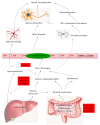Inflammation: A novel target of current therapies for hepatic encephalopathy in liver cirrhosis
- PMID: 26557005
- PMCID: PMC4631979
- DOI: 10.3748/wjg.v21.i41.11815
Inflammation: A novel target of current therapies for hepatic encephalopathy in liver cirrhosis
Abstract
Hepatic encephalopathy (HE) is a severe neuropsychiatric syndrome that most commonly occurs in decompensated liver cirrhosis and incorporates a spectrum of manifestations that ranges from mild cognitive impairment to coma. Although the etiology of HE is not completely understood, it is believed that multiple underlying mechanisms are involved in the pathogenesis of HE, and one of the main factors is thought to be ammonia; however, the ammonia hypothesis in the pathogenesis of HE is incomplete. Recently, it has been increasingly demonstrated that inflammation, including systemic inflammation, neuroinflammation and endotoxemia, acts in concert with ammonia in the pathogenesis of HE in cirrhotic patients. Meanwhile, a good number of studies have found that current therapies for HE, such as lactulose, rifaximin, probiotics and the molecular adsorbent recirculating system, could inhibit different types of inflammation, thereby improving the neuropsychiatric manifestations and preventing the progression of HE in cirrhotic patients. The anti-inflammatory effects of these current therapies provide a novel therapeutic approach for cirrhotic patients with HE. The purpose of this review is to describe the inflammatory mechanisms behind the etiology of HE in cirrhosis and discuss the current therapies that target the inflammatory pathogenesis of HE.
Keywords: Hepatic encephalopathy; Inflammation; Pathogenesis; Treatment.
Figures

Similar articles
-
Potential targeted therapies for the inflammatory pathogenesis of hepatic encephalopathy.Clin Res Hepatol Gastroenterol. 2015 Dec;39(6):665-73. doi: 10.1016/j.clinre.2015.06.020. Epub 2015 Jul 26. Clin Res Hepatol Gastroenterol. 2015. PMID: 26216028 Review.
-
Optimal treatment of hepatic encephalopathy.Minerva Gastroenterol Dietol. 2014 Mar;60(1):55-70. Minerva Gastroenterol Dietol. 2014. PMID: 24632768 Review.
-
Inflammation and hepatic encephalopathy.Arch Biochem Biophys. 2013 Aug 15;536(2):189-96. doi: 10.1016/j.abb.2013.03.016. Epub 2013 Apr 10. Arch Biochem Biophys. 2013. PMID: 23583306 Review.
-
Pathogenesis of hepatic encephalopathy in cirrhosis: the concept of synergism revisited.Metab Brain Dis. 2016 Dec;31(6):1211-1215. doi: 10.1007/s11011-015-9746-1. Epub 2015 Nov 2. Metab Brain Dis. 2016. PMID: 26521983 Review.
-
RiMINI - the influence of rifaximin on minimal hepatic encephalopathy (MHE) and on the intestinal microbiome in patients with liver cirrhosis: study protocol for a randomized controlled trial.Trials. 2016 Feb 29;17(1):111. doi: 10.1186/s13063-016-1205-8. Trials. 2016. PMID: 26926775 Free PMC article. Clinical Trial.
Cited by
-
Psychometric tests, critical flicker frequency, and inflammatory indicators in covert hepatic encephalopathy diagnosis.Hepatol Forum. 2023 Jan 17;4(1):19-24. doi: 10.14744/hf.2022.2022.0010. eCollection 2023 Jan. Hepatol Forum. 2023. PMID: 36843898 Free PMC article.
-
Quality of life as a therapeutic objective in the management of hepatic encephalopathy and the potential role of rifaximin-α.Eur J Gastroenterol Hepatol. 2021 Dec 1;33(1S Suppl 1):e1032-e1038. doi: 10.1097/MEG.0000000000002273. Eur J Gastroenterol Hepatol. 2021. PMID: 34402475 Free PMC article.
-
Effect of dihydromyricetin on hepatic encephalopathy associated with acute hepatic failure in mice.Pharm Biol. 2021 Dec;59(1):557-564. doi: 10.1080/13880209.2021.1917625. Pharm Biol. 2021. PMID: 33982639 Free PMC article.
-
Biological Activities of Lactose-Based Prebiotics and Symbiosis with Probiotics on Controlling Osteoporosis, Blood-Lipid and Glucose Levels.Medicina (Kaunas). 2018 Dec 3;54(6):98. doi: 10.3390/medicina54060098. Medicina (Kaunas). 2018. PMID: 30513975 Free PMC article. Review.
-
Ashwagandha-loaded nanocapsules improved the behavioral alterations, and blocked MAPK and induced Nrf2 signaling pathways in a hepatic encephalopathy rat model.Drug Deliv Transl Res. 2023 Jan;13(1):252-274. doi: 10.1007/s13346-022-01181-y. Epub 2022 Jun 7. Drug Deliv Transl Res. 2023. PMID: 35672652 Free PMC article.
References
-
- Vilstrup H, Amodio P, Bajaj J, Cordoba J, Ferenci P, Mullen KD, Weissenborn K, Wong P. Hepatic encephalopathy in chronic liver disease: 2014 Practice Guideline by the American Association for the Study of Liver Diseases and the European Association for the Study of the Liver. Hepatology. 2014;60:715–735. - PubMed
-
- Ortiz M, Jacas C, Córdoba J. Minimal hepatic encephalopathy: diagnosis, clinical significance and recommendations. J Hepatol. 2005;42 Suppl:S45–S53. - PubMed
-
- Prasad S, Dhiman RK, Duseja A, Chawla YK, Sharma A, Agarwal R. Lactulose improves cognitive functions and health-related quality of life in patients with cirrhosis who have minimal hepatic encephalopathy. Hepatology. 2007;45:549–559. - PubMed
-
- Bajaj JS, Saeian K, Verber MD, Hischke D, Hoffmann RG, Franco J, Varma RR, Rao SM. Inhibitory control test is a simple method to diagnose minimal hepatic encephalopathy and predict development of overt hepatic encephalopathy. Am J Gastroenterol. 2007;102:754–760. - PubMed
-
- Castro-Tavares J. Effects of isoprenaline and phenylephrine on plasma potassium: role of the liver. Arch Int Pharmacodyn Ther. 1975;218:110–119. - PubMed
Publication types
MeSH terms
Substances
LinkOut - more resources
Full Text Sources
Other Literature Sources
Medical

